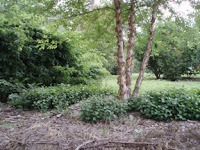When I planned my garden, we already had mature trees on the property, as well as, a small orchard. What I did was plan the shape of an intermediate-height garden in the sunnier locations, using bushes and small trees to lay out the form. The first four or five years, we planted crepe myrtle, flowering almond, yew, holly, ornamental cherry, river birch, and many others, some of which are no longer with us. I planted a dogwood one spring, and a sirocco raged through on an early, summer day and ignited it. Between morning and evening, the tree's young, green leaves withered to ashy, brown cinders.
As I was saying, when I planned my garden, one of the effects I wanted to produce was a feeling of antiquity. Our beautiful, mature trees were a good start, but I wanted ground covers to smooth out the harsh edges of new plantings and to give the illusion of time. In this goal, I haven't applied myself as well as I should have, but there are a few places where my attempts were rewarded. I have to give all the credit to the marvelous plants, which, despite my neglect and half-hearted attitude, thrive and spread.
I also give credit to Mom. All the groundcovers I list and picture below were started with plants from her garden. She had so much of each that a couple shovelfuls from the mass didn't even make a dent. (Love you, Mom.)
Ceratostigma plumbaginoides, also called leadwort or just plumbago. The green plant growing in low masses under the river birch and the plant in the foreground of the pot-pic is plumbago. In the background of the pot-pic is honeysuckle, with which I'm engaged in a battle. The honeysuckle wants to engulf the pot and everything else on that side of the fence, and I want it to stay put on the fence. Clip, clip, snip, snip, but I'm losing. Plumbago has one of those rare, blue, peacock-hued flowers (not blooming in these pics). Its leaves also turn a pretty shade of mahogany.
Vinca major, also called big leaf periwinkle. I call it Vinca major, except when I have one of my noun-attacks and start processing words through association to retrieve the desired noun! Then I sometimes call it periwinkle. This is a fast spreader, so I have to be careful where I introduce it. These are two, rough locations where I needed large, odd areas covered, so it works well, although I have some locations where I'm constantly pulling it out like a weed. Some years it has an abundance of pretty, blue flowers. Other years, it's less prolific. I'd like it better if it were more efficient at keeping tree seedlings from growing up through. Plumbago is better for that, but it doesn't spread as rapidly.


Vinca minor, also called periwinkle or creeping myrtle. I call it Vinca minor. It's a far more delicate plant than Vinca major, and it doesn't spread as rapidly. Its flower looks like major's. Overall, I prefer the growth habit and leaves of the Vinca minor. In this pic, I planted it at the base of a tree where the grass failed year after year. Sometimes I look stupidly at a site for years before inspiration (commonsense) finally strikes me. When I planted the Vinca minor here, it went crazy and solved my bare spot problem in only a couple seasons.
Stachys lanata or Lamb's ear. I call it Lamb's ear or, in the event of a noun-attack, Stachys. This awesome plant grows anywhere and will. In the sun, it blooms more abundantly and with sturdier stems, but I have it bloom in deep shade, too. Wherever even a small piece gets started, there will be a lush, wooly-soft, gray-blue mass of it the next year. I love it because of the furry leaves (which kids adore!), but I, especially, like to use it to make contrasting leaf-color/texture displays, which is what I've done here. I have it planted around my Hick's yew (yum, yum, yum, I love my Hick's), which is a rich, dark green all year (and needly). In front of it, I have a dainty-leaved, red shamrock. The only disadvantage of this plant, and there is ONLY one, is that I have to cut back the flower stalks after it blooms (blooming in this pic I took this morning). The bumblebees adore this plant's flowers, as do sphinx moths!!






No comments:
Post a Comment